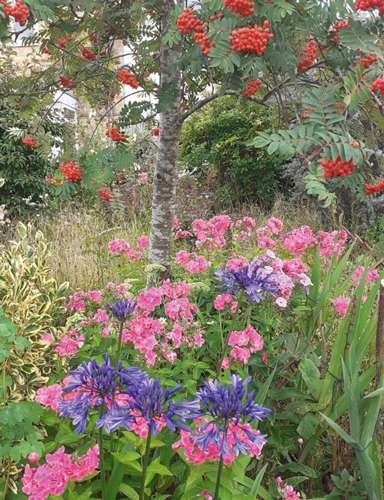
I continue to be amazed at garden plants’ ability to cope with the changing weather patterns and this year everything possible has been thrown at them, especially the torrential rain and high winds of the last few weeks of ‘summer’! Astonishingly, some hollyhocks grew to 8’, rudbeckia 6’ and even the annual cosmos over 5’, which make me feel very small as I wander round the garden looking admiringly upwards! Monty Don advised us a couple of weeks ago, to cut back the cosmos just above a new bud, to encourage a second flowering at a more reasonable height. I had taken some time this year, creating water butts to capture rain water and it has been very successful and has certainly cut down on the water bills.
The flowers along the High Street in Cranleigh are still looking magnificent but I have had to attack my pots of summer flowering plants, as the buds have rotted with the rain and they have stopped flowering. So, I have cleared away the lilies and geraniums ready to be stored for next year and replaced them with new hydrangeas for some late colour and these can then be moved to a new permanent location in the garden for next year. Also, we can do some protective action by shaking off the heavy water from large flower heads of daisies and hydrangeas, to stop the branches from breaking and removing the enormous snails, that have flourished in the damp conditions – I do prefer the flowers rather than slippery, slimy beasts!
There are still some lovely combinations of plants around, such as these red Rowan berries, above a mass of pink phlox and rich blue agapanthus flowers set amongst a mass of greenery as the back drop that I saw in a front garden in Cranleigh – perfect!
We reach full circle in the growing pattern in September, so it is normally the time to cut back, split and move various plants but because of the strong growth pattern this will have to wait until October but it does give us the chance to plan what steps need to be taken to restore some shape in the garden.
At last I can show you the very successful ‘shuttlecock’ structure for growing runner beans. As you can see the beans hang down freely on the outside, rather than getting caught up in other stems and leaves. The crop is later than usual because of the lack of sunshine but I still picked a kilo in the first haul. A friend has also used the idea and is delighted with his crop!
The wild flower area in my garden has become very straggly, so I will have to start again next year and there are wonderful displays at Wisley. King’s College Cambridge created a wonderful wildflower meadow and have now used shire horses to harvest the seeds, which will be used to create more meadows across the city next year. There is also another wonderful initiative at Sissinghurst to revive the Delos garden, which was started by Vita Sackville-West and Harold Nicolson in 1935 after they visited the Greek Island of Delos. The Kent climate, heavy Wealden clay and north-facing aspect of the Delos site, combined with Vita and Harold’s inexperience with Mediterranean plants meant that the garden never became what they had dreamed of. It lost its way and became a spring, woodland garden filled with ferns, hellebores, geraniums and sheets of scilla and narcissus.
Now a series of dry stone walls create new, gently raised beds, oriented to catch the southern sun and containing a new, free-draining soil mix. The original plants have been removed and replaced with plants that are primarily of Greek origin, augmented with others from the wider Mediterranean basin. The garden was officially opened in spring 2021 and it is well worth a visit. So, more advice will follow next month on how to divide plants and feed the soil, so they become established before the cooler months.












